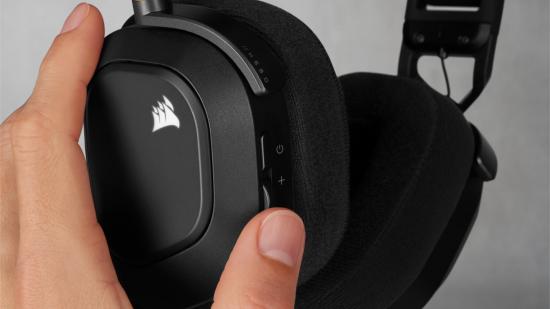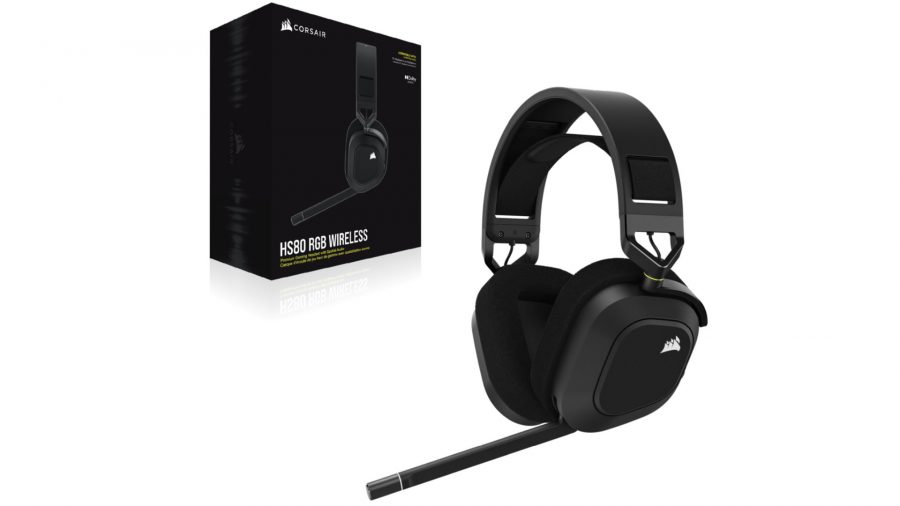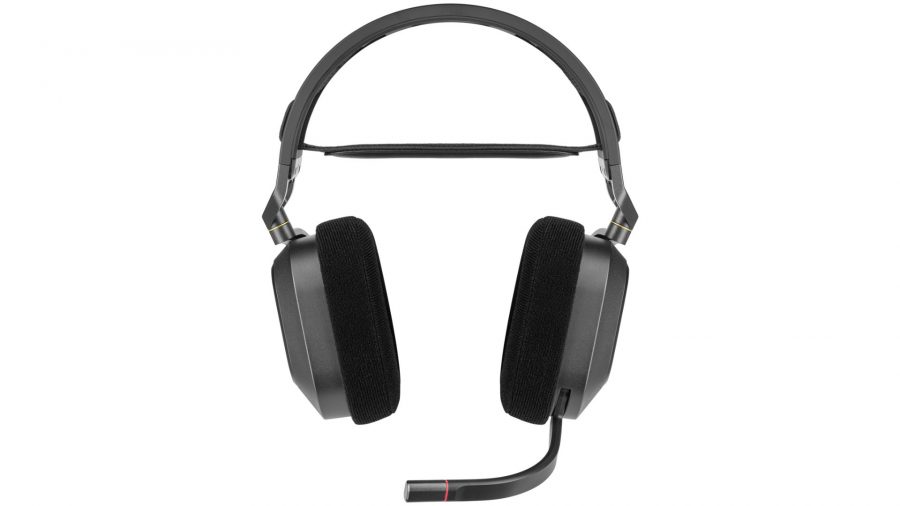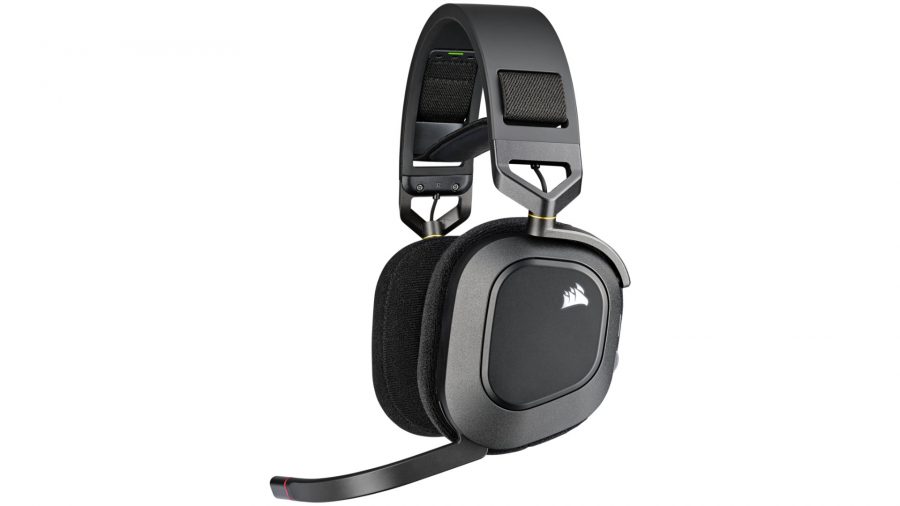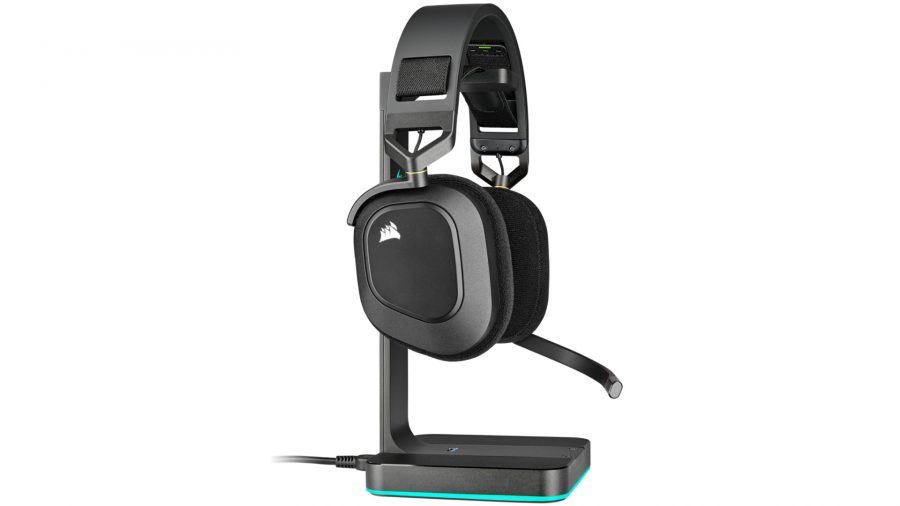Our Verdict
The out-of-the-box sound needs adjusting, which isn’t great for the casual user, but with a little effort the HS80’s rich spatial audio and excellent microphone set it apart from the competition.
The Corsair HS80 is a wireless gaming headset with RGB, spatial audio, and a recommended retail price of $149.99 / £139.99 – not quite reaching the premium heights of the Corsair Virtuoso XT, but far from a budget choice.
The HS80’s specialisation is, unsurprisingly, gaming. The headset’s designed to deliver the most accurate spatial audio experience possible using Dolby Atmos, with its 50mm drivers handling a respectable 20Hz-40kHz frequency response. Ostensibly this will help you identify each and every little goblin/gunman/gelatinous blob scuffling around your periphery and avoid getting shot in the head, or at least identify where you got shot from.
The HS80 isn’t quite an all-rounder, however; there are a few issues to consider, including the HS80’s sound profile and limited connectivity options. The HS80 only offers two methods of connection: 24-bit 96kHz USB wired and 24-bit 48kHz wireless via a USB dongle. The wireless range is advertised at 60ft, though presumably that’s unobstructed; in my small flat, it starts cutting out as I leave the room and walk down the hall. It’s decent, but nothing impressive. There’s no Bluetooth, so it won’t play with your phone, although the HS80 is compatible with consoles and Macs.
Why you can trust our advice ✔ At PCGamesN, our experts spend hours testing hardware and reviewing games and VPNs. We share honest, unbiased opinions to help you buy the best. Find out how we test.
By far, my least favorite thing about the HS80 is its sound profile. Out of the box, without any custom sound profiles or equalization, it sounds disappointingly muddy, with far too much low mid – it almost sounds like I’m listening to music from the next room. Switching to my custom EQ preset feels like opening the door and stepping into the room by comparison. The difference was obvious enough to notice on the few occasions the Corsair iCUE software reverted to the default profile on boot up, causing quite the confusion before I realized my settings weren’t in place.
| Corsair HS80 | Corsair HS70 | SteelSeries Arctis 7P | Corsair Virtuoso RGB Wireless XT | |
|---|---|---|---|---|
| Drivers | 50mm | 50mm | 40mm | 50mm |
| Frequency response |
20Hz – 40kHz | 20Hz – 20kHz | 20Hz – 20kHz | 20Hz – 40kHz |
| Connectivity | Wireless | Wired | Wireless | Wired | Wireless | Wired | Hybrid |
| Battery life | Up to 20 hours | Up to 16 hours | Up to 24 hours | Up to 15 hours |
| Mic response | 100Hz – 10kHz | 100Hz – 10kHz | 100Hz – 6.5kHz | 100Hz – 10kHz |
| Weight | 367g | 314g | 422g | Up to 382g |
| Price | $149.99 | 139.99 | $179.99 | £99.99 | $149.99 | 174.99 | $249.99 | £249.99 |
To be fair, the native settings are undoubtedly designed to prioritize clarity of sound while gaming over a balanced profile for listening to music – and sure enough, with the ‘Game’ preset applied in Dolby Access (and ‘performance mode’ enabled), I can easily pinpoint the directional sound. Sure, this is a gaming headset review for a gaming site, so the HS80 putting games on a pedestal isn’t exactly a cardinal sin, but to be more specific, it’s balanced for utility so you can hear an enemy sneaking up on you, rather than for aesthetics to bring out the best in the game’s soundtrack.
Fortunately, the aforementioned EQ tools can redress the balance, if you so choose. iCUE comes with a ten-band equalizer; the default presets aren’t wonderful, but the equalizer is easy enough to tinker about with, as it clearly shows the +-dB of each frequency band and you can hear the results immediately. Alas, the same can’t be said for the Dolby Access software, which you’ll need to install to use Atmos.
With Atmos applied, you’re locked out of iCUE’s EQ and have to use Access – its default presets are even worse for music, and the equalizer doesn’t tweak the sound live, instead requiring you to configure it and click ‘apply’, reloading the audio renderer every time. This is a bit of a nightmare when it comes to fine-tuning your sound, as you don’t get that instant feedback to help you figure out where the levels should be.
As a result, it’s easier to figure out your EQ preferences in iCUE and then replicate them in Access afterward. As a starting point, we recommend you dip the low mids by about 3-4dB at 250Hz and 500Hz, boost the top end around 1-2dB starting at 2kHz, and then add additional bass and treble to taste. EQ is largely down to personal preference and is a difficult tool to use if you’re not familiar with it, so it’s a shame it’s crucial to getting the best sound out of the HS80.
The iCUE software also includes options to turn off the headset’s voice prompts (which I find a little obnoxious, but they may be useful for others), set the auto shut-off timer, and customize the RGB. The HS80’s lighting consists of an illuminated logo on each side, so the overall effect is minimal and understated. You can also turn the RGB off entirely, which I’ve opted to do in order to preserve the HS80’s battery life.
My experience of the HS80’s wireless battery life is varied. Advertised at 20 hours, it sometimes dies under ten hours with RGB on, which is disappointing – and since I’d turned off the voice prompts, it took me a while to realize what I thought was a natural lull in my Discord call was just me failing to hear anything through a dead headset.
The HS80 doesn’t charge quickly but can be used while it’s charging, plugged in via USB. Switching between wired and wireless is somewhat fiddly; you need to turn the headset off before plugging it in and switching it back on again, which can be a little disruptive mid-game. The wireless sound quality is excellent, and virtually indistinguishable from wired. The wired mic quality is phenomenal, garnering several compliments, and while it’s (understandably) not as crisp in wireless mode, it’s still the best wireless mic I’ve ever used, rivaling the desktop gaming microphones.
The microphone isn’t detachable, but the HS80 isn’t a headset you’ll be bringing out and about with you (which would be difficult anyway, owing to the HS80’s limited connectivity options). You can mute the mic by raising the arm, and a helpful light at the end turns from red to white when the mic is lowered and active; the combination of these two features means accidentally broadcasting yourself at inopportune moments is virtually impossible. Thank you, Corsair.
You can bend the mic arm to curve toward your face, which is a feature I didn’t actually notice for a few weeks (look, I’m not in the habit of forcefully twisting my tech around) but it’s much appreciated, allowing you to find the perfect spot as close to your mouth as possible without it getting in the way.
A sidetone is an option in iCUE if you fancy hearing yourself through your microphone, though in my experience there’s no need for this as there isn’t much in the way of isolation with the HS80 – you can still hear everything going on in the room around you, and anyone nearby will be able to hear sound leaking out. This isn’t a problem for me but is definitely a matter of personal preference.
A lack of isolation is expected, as instead of tightly enveloping your ears, the HS80 gently cushions them with large plush memory foam pads covered in cloth. This means the headset looks a bit bulky and wide overall, but it’s certainly comfortable to wear for hours on end and doesn’t get uncomfortably warm (at least, not in winter). The ‘floating’ headband design ensures a flexible but snug fit, and I’m happy to report it hasn’t fallen off my head (yet).
It’s worth mentioning that I encountered an issue with the first test unit I was sent – after a short time of using it in wireless mode, the connection would begin to cut out intermittently, and eventually stop working entirely. This may have been a hardware issue, as our replacement headset works perfectly fine without any hitches.
So, if you’re looking for a wireless headset for competitive gaming sessions over voice chat, the HS80 ticks quite a few boxes and comes with a couple of caveats. It’s either all work or all play, as you won’t be able to get a full day of both out of it; you won’t be able to wander too far away from your gaming PC considering the headset’s signal can’t stretch as far as its competitors; and you’ll need to fiddle with the EQ settings to get an even sound if you’re bothered about music. But once that’s sorted, the HS80 sounds great, feels comfortable to wear, and best of all, makes your voice sound crystal clear.
